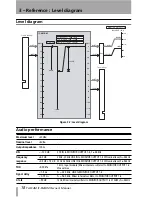
2 – Using the card : ROUTING option
TASCAM IF-SM/DM Owner’s Manual
7
Notes on other hardware controls
MONO key
When the card is being used for
monitoring in surround mode, the
MONO
key
on the control surface is used to turn downmix
on and off (as set up in
DOWN MIX
).
DIM key
The
DIM
key on the control sur-
face can be used in the usual way to dim the
outputs from the card. The dimming level is
set in the mixer.
ROUTING option
There are two main functions here. The first
allows you to set up the monitoring keys, and
the second allows assignment of the outputs
to the different channels.
Figure 2.4: ROUTING option screen
Monitoring keys
The three assignable monitor selection hard-
ware keys in the mixer’s monitoring section
can be set here.
The following can be selected as monitor
sources (stereo):
• Individual Aux busses
• Pairs of Aux busses
• Individual busses
• Pairs of busses
• Digital inputs (1 or 2)
• 2 TR analog inputs
• The TDIF signals (1 through 3)
• The ADAT signal
• The signal of any card in a slot other than
the surround monitor card
In LRCS, 5.1 or 6.1 modes:
• Surround buss 1–8
• Surround buss 9–16
• Digital inputs (1 or 2)
• The TDIF signals (1 through 3)
• The ADAT signal
• The signal of any card in a slot other than
the surround monitor card
Output routing
When a “Line” is referred to in this screen, it is
referring to the analog output line from the IF-
SM/DM card (as shown in Table 1.2,
Pin
assignments of the IF-SM/DM analog outputs
)..
The lines can be assigned to the different chan-
nels used by the surround pattern currently
selected, differing from the default assignments
made when the surround pattern is selected.
These channels are shown as
L, R, C
, etc. If a
line output is unused by the pattern, as output
8 is unused in Figure 2.4,
ROUTING option
screen
, it is shown with the number and
dashes (
-8-
).
Note that loopback routing is not possible in
this case (see Figure 3.2,
Level diagram
).



















